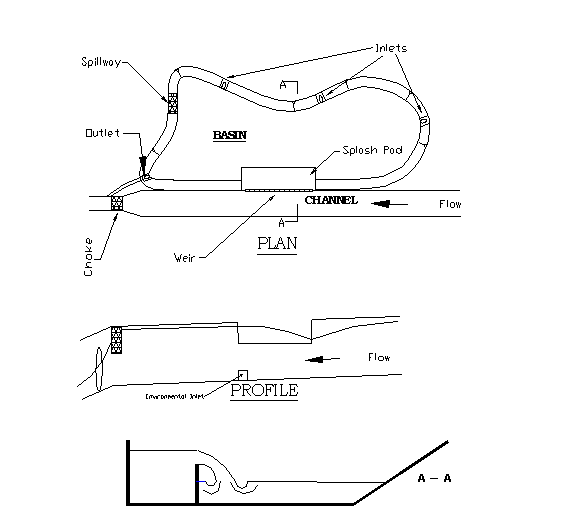
Video of B.A.S. features
Offline Basins &
Basin Analysis Software [B.A.S].
Retarding flows has been a classic approach for reducing/controlling flows to downstream channels. There are two types of retarding basins which accomplish this goal: 1) the classic online (flow-through) basin, and 2) the offline (flow-by) basin. An example of an online basin is a reservoir behind a dam, where large flows pond behind the dam and a much smaller flow is released through the outlet.
In contrast, offline retarding basins divert flows over a side-weir and into the retarding basin, once the water surface in the channel exceeds the weir crest. Therefore, the basin does not receive stormwater for a significant part of the storm. In essence, the required flood storage volume is significantly smaller in contrast with online retarding basins. This also results in significant savings by reducing the required land area. They are also more environmentally-friendly than classic online basins and require far less maintenance. They allow sediment transport to the downstream system, which reduces erosion, and allows for free fish-passage to the upstream of the system. In addition to their flood control function, such systems often serve secondary purposes such as water quality enhancement, percolation and recreation.
B.A.S. represents the state-of-the-art in modeling side-weirs and offline retarding systems and was developed to provide a user -friendly tool for the complete design, analysis and optimization of side -weirs and offline retarding systems. Until B.A.S.’s debut, no software was available to the hydraulic professional to perform such complex design and analyses. While the development of B.A.S. absorbed several years of programming, debugging and verification of results, many more years of hydraulic expertise is behind the theoretical concepts used in the program. To appreciate the thoroughness of the theory research, one must review the User’s Manual. In part, the manual delves into the over one -hundred year history of the development of side -weir formulae. Then, a method is chosen which is based upon over 45 years of use by the Orange County Flood Control District in Southern California.
BAS is available for licensing. However, due to the unique application of this tool, Nadeem encourages attending a course on its use/application. This is a very comprehensive, 8-hour, hands-on course
